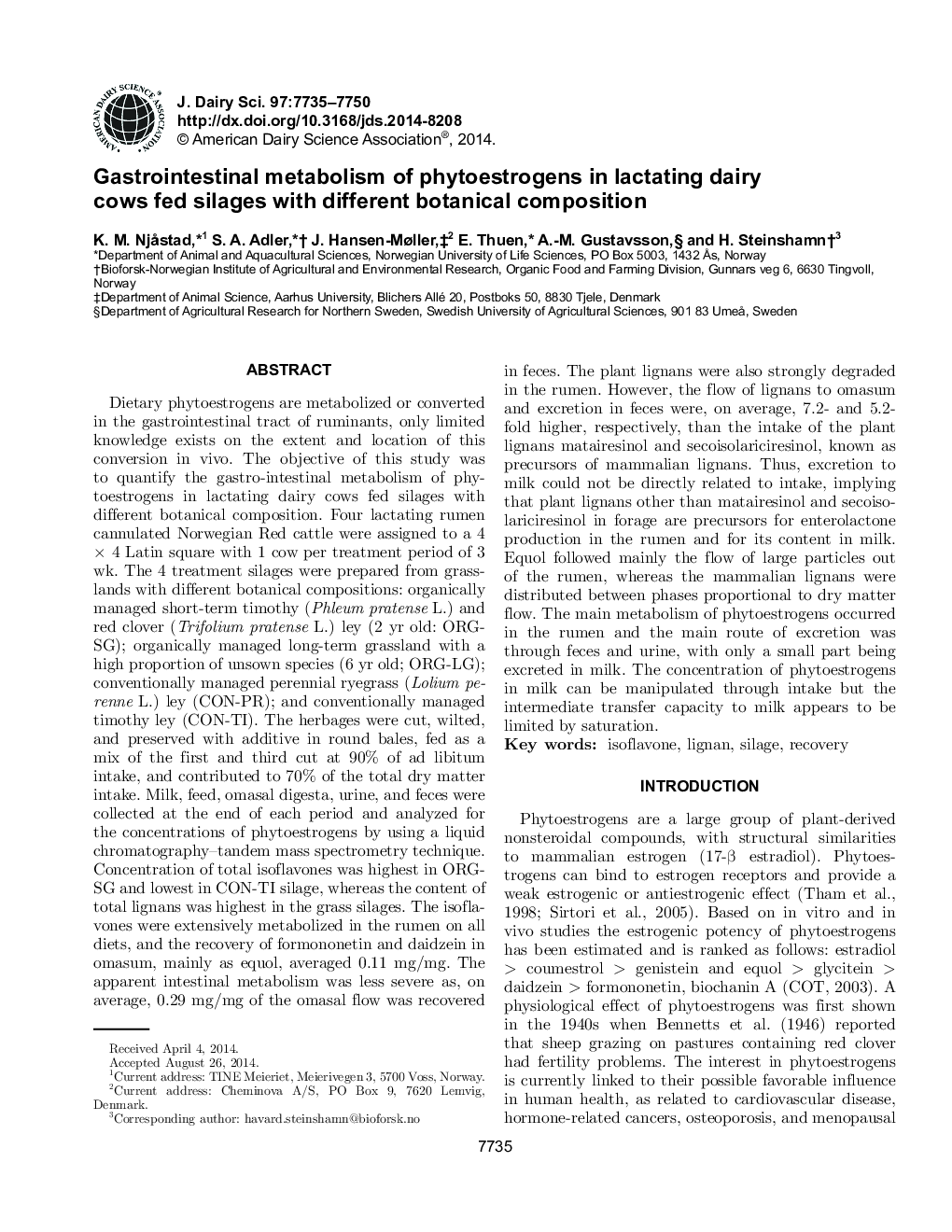| کد مقاله | کد نشریه | سال انتشار | مقاله انگلیسی | نسخه تمام متن |
|---|---|---|---|---|
| 10973491 | 1108015 | 2014 | 16 صفحه PDF | دانلود رایگان |
عنوان انگلیسی مقاله ISI
Gastrointestinal metabolism of phytoestrogens in lactating dairy cows fed silages with different botanical composition
ترجمه فارسی عنوان
متابولیسم دستگاه گوارش فیتواستروژن ها در گاو شیرده تغذیه سیلوهای با ترکیبات مختلف گیاه شناسی
دانلود مقاله + سفارش ترجمه
دانلود مقاله ISI انگلیسی
رایگان برای ایرانیان
کلمات کلیدی
ایزوفلاون، لیگنان سیلیس، بهبود،
موضوعات مرتبط
علوم زیستی و بیوفناوری
علوم کشاورزی و بیولوژیک
علوم دامی و جانورشناسی
چکیده انگلیسی
Dietary phytoestrogens are metabolized or converted in the gastrointestinal tract of ruminants, only limited knowledge exists on the extent and location of this conversion in vivo. The objective of this study was to quantify the gastro-intestinal metabolism of phytoestrogens in lactating dairy cows fed silages with different botanical composition. Four lactating rumen cannulated Norwegian Red cattle were assigned to a 4Â ÃÂ 4 Latin square with 1 cow per treatment period of 3 wk. The 4 treatment silages were prepared from grasslands with different botanical compositions: organically managed short-term timothy (Phleum pratense L.) and red clover (Trifolium pratense L.) ley (2 yr old: ORG-SG); organically managed long-term grassland with a high proportion of unsown species (6 yr old; ORG-LG); conventionally managed perennial ryegrass (Lolium perenne L.) ley (CON-PR); and conventionally managed timothy ley (CON-TI). The herbages were cut, wilted, and preserved with additive in round bales, fed as a mix of the first and third cut at 90% of ad libitum intake, and contributed to 70% of the total dry matter intake. Milk, feed, omasal digesta, urine, and feces were collected at the end of each period and analyzed for the concentrations of phytoestrogens by using a liquid chromatography-tandem mass spectrometry technique. Concentration of total isoflavones was highest in ORG-SG and lowest in CON-TI silage, whereas the content of total lignans was highest in the grass silages. The isoflavones were extensively metabolized in the rumen on all diets, and the recovery of formononetin and daidzein in omasum, mainly as equol, averaged 0.11Â mg/mg. The apparent intestinal metabolism was less severe as, on average, 0.29Â mg/mg of the omasal flow was recovered in feces. The plant lignans were also strongly degraded in the rumen. However, the flow of lignans to omasum and excretion in feces were, on average, 7.2- and 5.2-fold higher, respectively, than the intake of the plant lignans matairesinol and secoisolariciresinol, known as precursors of mammalian lignans. Thus, excretion to milk could not be directly related to intake, implying that plant lignans other than matairesinol and secoisolariciresinol in forage are precursors for enterolactone production in the rumen and for its content in milk. Equol followed mainly the flow of large particles out of the rumen, whereas the mammalian lignans were distributed between phases proportional to dry matter flow. The main metabolism of phytoestrogens occurred in the rumen and the main route of excretion was through feces and urine, with only a small part being excreted in milk. The concentration of phytoestrogens in milk can be manipulated through intake but the intermediate transfer capacity to milk appears to be limited by saturation.
ناشر
Database: Elsevier - ScienceDirect (ساینس دایرکت)
Journal: Journal of Dairy Science - Volume 97, Issue 12, December 2014, Pages 7735-7750
Journal: Journal of Dairy Science - Volume 97, Issue 12, December 2014, Pages 7735-7750
نویسندگان
K.M. Njåstad, S.A. Adler, J. Hansen-Møller, E. Thuen, A.-M. Gustavsson, H. Steinshamn,
